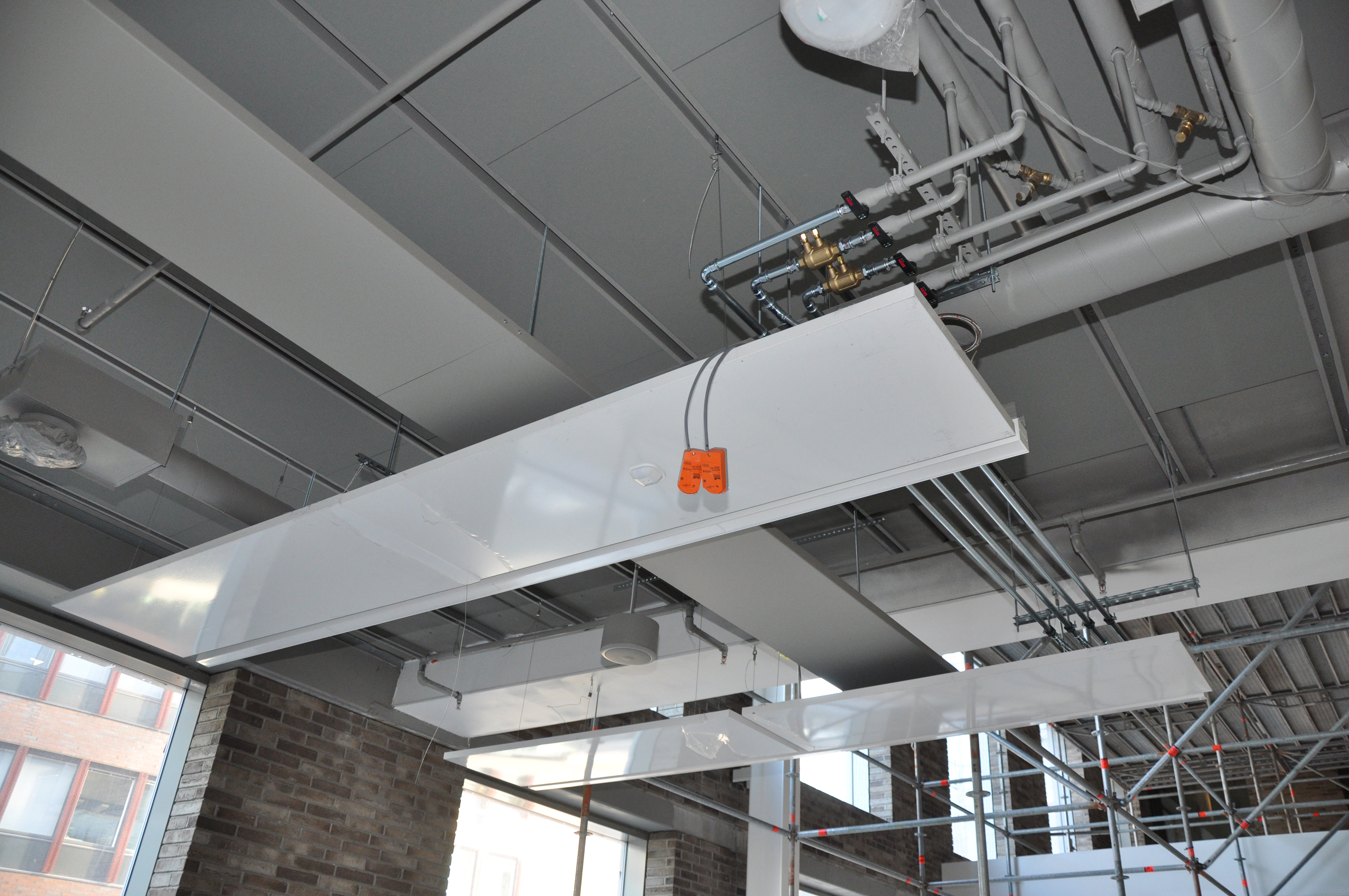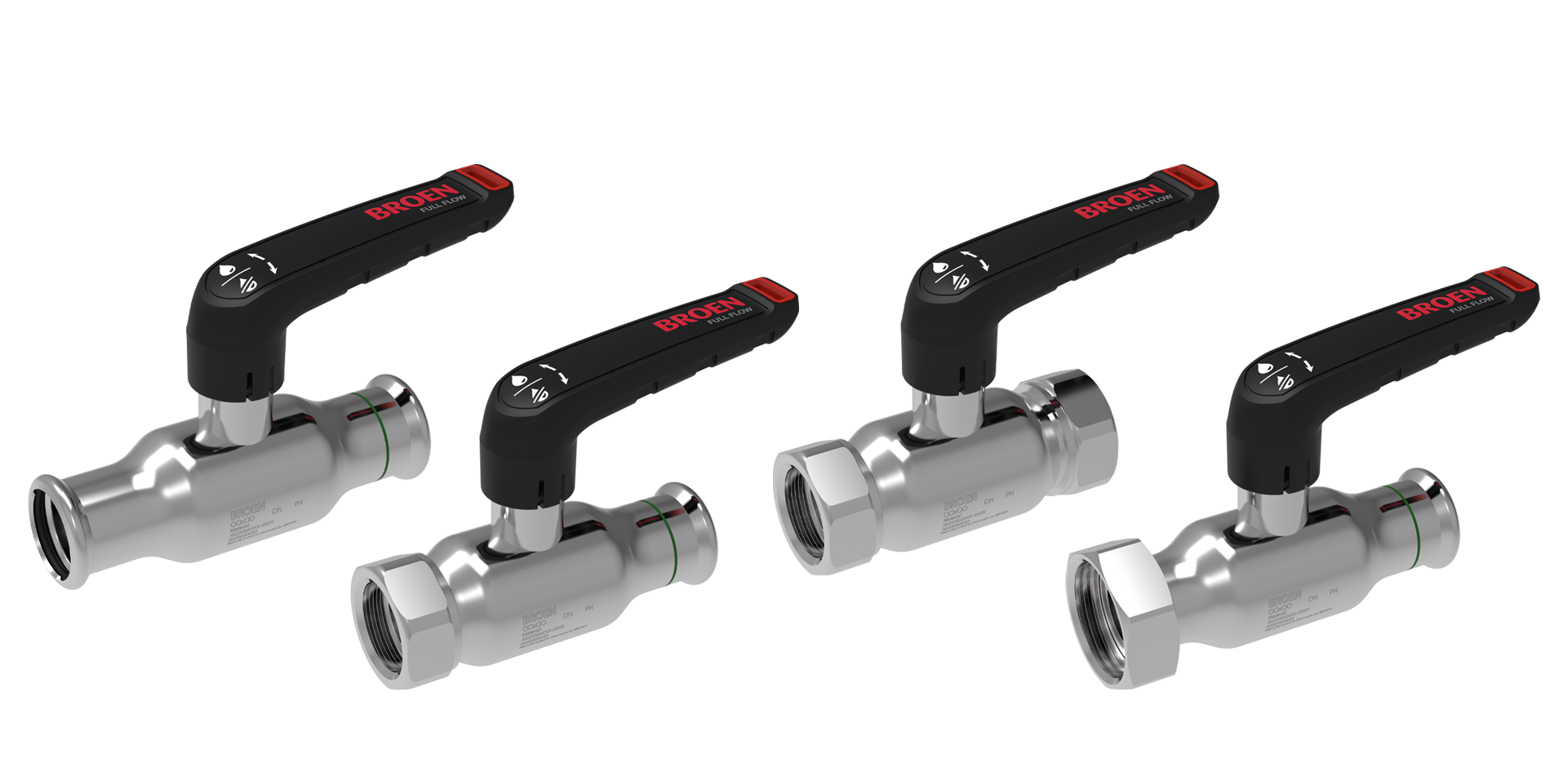BROEN FULL FLOW The practical benefits

BROEN FULL FLOW a more efficient choice for heating and cooling system
The energy efficiency requirements of buildings and the expectations of users in terms of comfort of use and living comfort have complicated the heat distribution networks of buildings, and nowadays a heat emitter other than a traditional radiator often serves as a terminal device in the system. Different types of heat exchangers and air fans are used to create even conditions for the residential zones in the rooms. Cooling is also often built into the property, so the indoor conditions can also be controlled to prevent the premises from overheating. The usual way to implement space-specific cooling is to use, for example, passive radiant panels or fan convectors.

BROEN FULL FLOW in acid-resistant and electro-galvanised steel - for all systems
Common to all terminal devices of heating and cooling systems is that it is necessary to install reliable shut-off valves in connection with them, in which case the maintenance of the individual terminal device becomes easier and does not cause excessive interruptions to the heating or cooling of other spaces. Numerous different terminal devices bring with them numerous different connection methods, in which case the importance of valve selection is also emphasized: whether to choose a traditional implementation, in which the installer assembles a multi-part assembly, where the risk of leakage increases significantly with several connections, or whether to choose a valve that can be connected directly to the connection hoses of the terminal device.
BROEN FULL FLOW is the first next generation ball valve family, which combines a reliable shut-off valve and a wide range of connections. The widest valve family on the market includes more than 500 options in sizes DN 10–50. The valve is made of electro-galvanized or stainless steel, so there is a suitable valve for almost any piping system.

Life cycle emissions and costs of valves
In terms of the energy efficiency of the heating and cooling network, the biggest single positive action is the proper insulation of the system. Shut-off valves are usually left uninsulated, in which case the heat loss during the life cycle of the valve causes many times more emissions than the manufacturing of the valve itself - and financial costs.
BROEN FULL FLOW is available with both a traditional low spindle and a high spindle, which, together with the very compact structure of the valve, enables the valve to be isolated tightly and quickly.

Source of the graph: Vasko, V.: Environmental Impacts of Ball Valves, 2021.

Flow responses
The more complex the system, the more important it is to minimize unnecessary flow resistances. When choosing shut-off valves, it is of the utmost importance to make sure that the selected valves are full-bore. The majority of shut-off valves are reduced bore, in which case the pressure loss caused by them is significantly greater than that of a full-bore valve. In picture 3, the pressure drop graphs of BROEN FULL FLOW and a reduced bore valve of the same nominal size are shown side by side.

One system - one material
Galvanic corrosion is a problem particularly in open systems where oxygenated circulating water acts as an electrolyte. In closed systems, there is usually no oxygen, so the risk of oxidation and galvanic corrosion is low. During system maintenance, tap water is usually used to fill the network, allowing oxygen to enter the circuit, which also causes galvanic corrosion at the joints between different materials for a short period of time.
In addition to the risk of internal corrosion, external corrosion must also be considered, especially when designing and building cooling and heating networks. Moisture condenses on cooler pipe surfaces and acts as an electrolyte at the joints between materials. Although condensation can be prevented by tight insulation, it is recommended that materials are selected to prevent galvanic corrosion. As BROEN FULL FLOW is made of the same material as the pipe, there is no electrochemical coupling between the valve and the pipe and no risk of galvanic corrosion.

BIM-based design
As BIM based building design becomes more common, the importance of up-to-date 3D models of products is also emphasized in HVAC design. BROEN FULL FLOW valves can be found in MagiCAD Cloud, where the 3D models of the entire selection can be downloaded to both AutoCAD and Revit. The downloadable models contain the technical characteristics of the valves, making it easy to select the most suitable valve for the system and to model flow losses with verified data. MagiCAD Cloud also includes the most common BROEN BALLOMAX® and BROEN BALLOREX products.
Access MagiCAD Cloud here: https://www.magicad.cloud/products/.

Sustainability
Although minimizing the energy consumption of valves during operation is very important, in order to slow down climate change, efforts must also be made to minimize the emissions caused by their manufacture and transport.
BROEN is committed to this goal with an ambitious environmental program, the goal of which is to reduce the carbon emissions of the company by 70 percent by 2026. The biggest measures aimed at achieving the goal are the transition to green, origin-verified electricity, the construction of solar power plants at production sites, and the construction of a new energy-efficient production plant in Denmark.
BROEN is also committed to the UN sustainable development goals. In order to increase the transparency of the environmental effects caused by the products, BROEN has as the first step published an environmental product declaration for its stainless steel BROEN FULL FLOW valves.
You can access EPD-Hub here:
https://www.broen.com/documentation/environment-quality/environmental-product-declaration-epd/


What does next generation valve technology mean in practice? BROEN FULL FLOW valves are a good example of striving for responsible consumption of energy, and natural resources. Compared to the traditional welded valves, the weight of the valve is almost a third less, the number of components in the valve is 26 percent smaller, there are 50 percent less manufacturing steps, and the energy consumption of the welding process required to assemble the valve is a whopping 97 percent lower. This, combined with a first-class valve in terms of flow characteristics, installability and quality, is the next generation of valve technology.
Read more about Green Thinking by BROEN